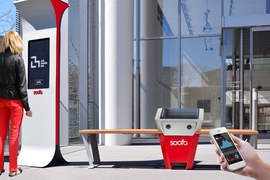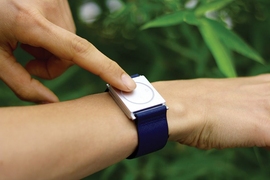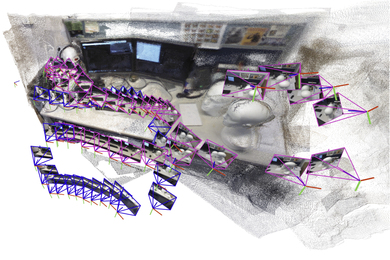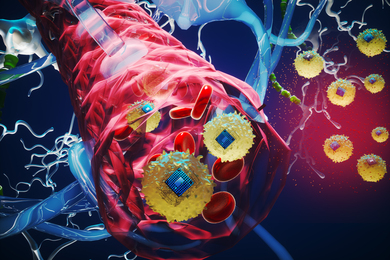MIT research scientist Richard Fletcher directs the Mobile Technology Group at MIT D-Lab, which develops a variety of mobile sensors, analytic tools, and diagnostic algorithms to study problems in global health and behavior medicine. Utilizing mobile technologies — which include smartphones, wearable sensors, and the so-called internet of things — his group applies these technologies to real-world social problems with global implications. These issues involve a variety of areas, such as environmental monitoring and air pollution, agriculture, farming, and global health.
Fletcher notes that public health is of enormous importance and includes a wide range of diseases and conditions. His work at D-Lab has a myriad of applications: Sometimes this means simply doing better point-of-care diagnosis of acute or chronic diseases; other times, the focus is on screening and identifying those who are sick but don’t realize it. “For example, consider the fact that every two minutes around the world a woman dies in childbirth. This is something that is for the most part preventable if problems can be detected ahead of time,” Fletcher says.
Fletcher’s group also creates tools that promote healthier behaviors and lifestyles. In addition to cardiometabolic diseases, such as diabetes, he points to the multitude of mental health disorders, like depression, anxiety disorders, sleep disorders, and the crisis of substance abuse, which negatively impact millions of lives, as areas that are in severe need of better solutions. His work seeks to apply technology to address many of these fundamental social problems affecting people on a daily basis.
“Mobile technology is a double-edged sword,” says Fletcher. “Addiction to smartphones and social media are emerging as serious problems, and most mobile health apps on the market have never been validated or tested clinically. But our group is trying to change that, and demonstrate that mobile technology can be a powerful tool to positively impact people’s health.”
While some might question whether this type of public health work has a place at an engineering school, Fletcher insists that the combination of technical knowledge coupled with the freedom to seek out novel approaches to design flaws are part of what makes MIT D-Lab the ideal setting for the work. Fletcher’s philosophy with regard to the intersection of technology and health is global. He is adamant in his belief that the design constraints encountered in the developing world must be considered and confronted in the early stages of design. While health researchers and doctors don’t generally have the luxury of designing their technology, and instead usually customize what is available, Fletcher’s group is uniquely interdisciplinary and designs everything from the ground up: from the electronic circuit boards and firmware to the software and the algorithms to the network communications and server-side software. He believes the incorporation of this knowledge will ultimately produce a superior product, best suited to the end customer and their constraints.
“Having this feedback loop that extends from the early stages of technology development all the way to clinical field studies, is the true marriage of technology and global and public health,” Feltcher says. In his view, developing countries need the most advanced technology that is simplified so it may be used by people with lower technical skills and less training. But Fletcher is quick to point out that this doesn’t mean dumbed-down versions. Rather, the opposite is true; the tools must be endowed with an extremely high level of intelligence, including machine learning algorithms to provide diagnostic support, and also the use of technologies such as augmented reality to make the interface easy to use. “We often say, we like to empower ordinary people to do extraordinary things. This is what technology should really be about.”
Global health was not Rich Fletcher’s initial field interest. Rather, he devoted the first stages of his career, including graduate school and time in the military, to the development of wireless sensors and radio frequency identification (RFID). At that time, he was interested in the early visions of the internet of things, which led to thinking about ubiquitous computing. One of the fundamental tenets of that vision was that every object in our environment should have its own unique ID. Fletcher worked with Kevin Ashton at Proctor and Gamble, who coined the term “internet of things” together with his MIT advisor Neil Gershenfeld. Building on his five-year research experience at the U.S. Air Force Materials Lab, Fletcher worked with Gershenfeld to create unique ID codes embedded within smart materials themselves.
“Every material has its own electromagnetic signature,” he explains, “and you can use that signature to identify the things in your environment.” The next step in the puzzle involved researching how to apply material structures to do the sensing in the environment. Fletcher says, “You not only want the devices in your environment to have an ID, and be able to talk to them, but you also want them to sense what is going on. Things as simple as light, vibration, temperature, and so forth.” He created sensors made from low-cost materials, which spawned his startup Tag-Sense, and spinoffs including Fresh Temp, which was acquired a few months ago by internet of things company Digi.
Working with one of the world’s first RFID companies, Indala Corporation, and then later MIT groups led by Gershenfeld and MIT Professor Sanjay Sarma, Fletcher has been integral to the evolution of RFID technology. From identification, to sensing, to communication protocol that allows these things to talk to one another, and even to the idea of energy harvesting, or how to use vibration, light, and heat to power these things and create micro-batteries or energy harvesting circuits. After completing his PhD at the Media Lab, Fletcher also built sensors for living plants and agriculture, inspired by JC Bose in Calcutta, India, who was one of the first people to detect and produce radio waves in the late 1800s. Bose proved that plants have primitive nervous systems and can communicate with their environments. It was this work with signals that attracted Fletcher to the signals produced by biological systems and the living things themselves (i.e., plants, animals, humans). “I discovered that there is enormous complexity in these signals, and an enormous opportunity to explore these signals for health applications. I also learned that we can apply machine learning and other advanced analysis to the data produced by humans, animals, and plants, and be able to create some very powerful tools for analyzing and improving our health.” Fletcher then went on to build wearable sensors for children with autism with Professor Rosalind Picard at the MIT Media Lab and also made wearable sensors for monkeys and primates with Institute Professor Ann Graybiel, who studies the neuroscience of addiction.
Working with smartphones led Fletcher to the realm of mental health. With the phone’s ability to deliver images, videos, and sounds, and connect to other people, Fletcher suggests we can think of our phones as a drug delivery device, capable of delivering therapy outside the clinic. Creative utilization of the technology has spawned forward thinking models for helping those in need. For example, his group has recently partnered with a preeminent yoga school in India to develop mobile tools that will help train people to meditate as a means to alleviate stress and manage pain.
Fletcher also recognizes the difficulties inherent in mobile technologies and wearable sensors. Oftentimes those who need these technologies are the most resistant to wearing them (for example, elderly people or people with mental health issues). For this reason, he and his group are developing technologies that can measure physiology and monitor behavior in a non-contact manner, without the need for wearable sensors, utilizing devices such as low-cost Doppler radar devices imbedded in car seats, walls, or furniture, to measure heart rate and respiration. He also uses special cameras and thermal imaging, even odors emitted from the human body. All of these technologies and signals can tell us about our health. In his eyes, this “ubiquitous sensing” is the future direction of the field.
An essential element to Rich Fletcher’s work is the desire for his research have a significant impact in the real world. As such, entrepreneurship, and by extension partnering with individuals, startup companies, or organizations, is integral to his endeavors. Because Fletcher is interested in sustainability of the product and the business model. It is not only a marriage of technology and health, but also an embrace of the multi-faceted process required to positively impact the world. “Now is really an exciting time,” Fletcher says. “The vision we had 20 years ago of the internet of things is now finally becoming a reality. Now that the technology has matured, we’re starting to look at what we can do with these technologies and what is possible. And that’s what my group does today. We look at how we can apply all these wonderful mobile wireless technologies in ways that can have real social impact and apply them to solve real social problems.”









